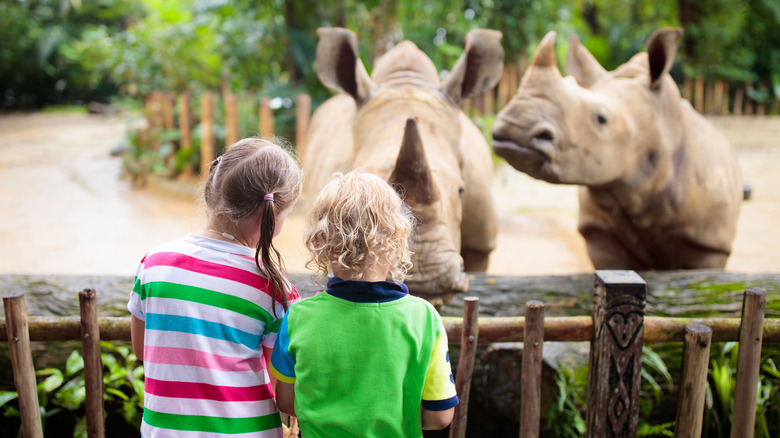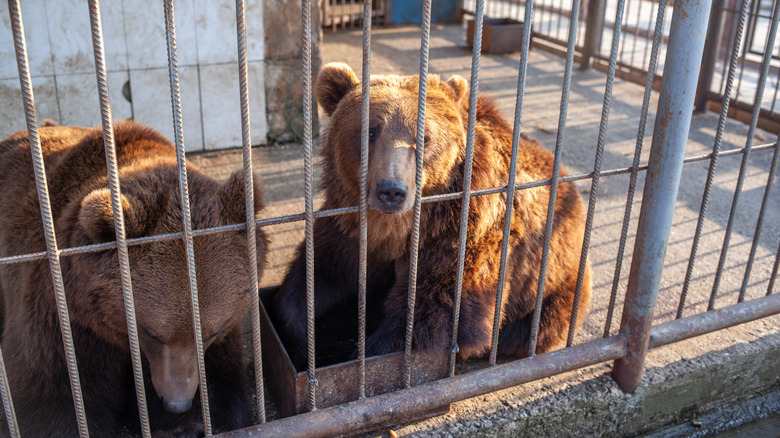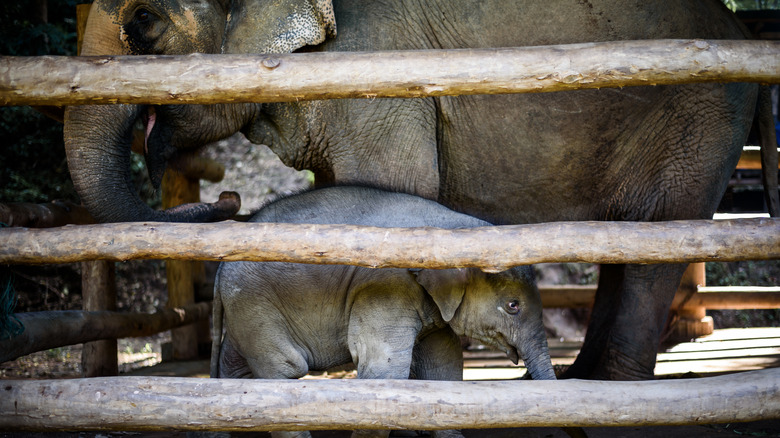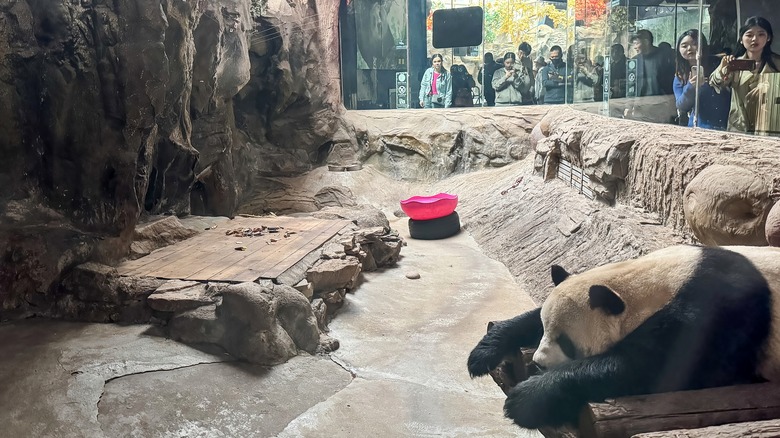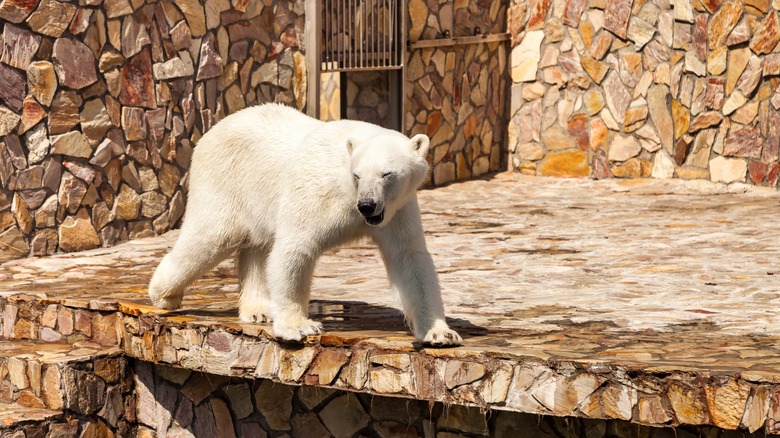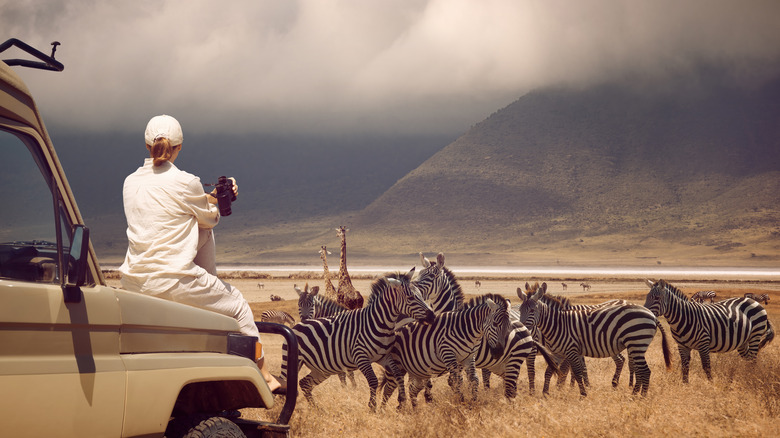Why Tourists May Want To Think Twice Before Visiting Zoos During Family Vacations
Chances are that at some point during your life, you've visited a zoo. Maybe as a wide-eyed child or as a parent taking your kids to see exotic animals up close. Zoos have long been a fixture of family holidays, offering a glimpse of the wild without having to leave the city. The U.S. alone is home to 350 zoos that draw millions of visitors annually. But whether you go to a zoo on U.S. soil or overseas, the safety risks, poor quality of enclosures, misleading conservation claims, priority of entertainment over education, and heavy focus on profits are some reasons you may want to reconsider visiting on your next family vacation.
Wild animals have been captured and displayed for human entertainment for thousands of years, even dating back to ancient Egypt where they were kept as symbols of social status, and the Roman Empire when exotic animals were used in the arenas. Fast forward to today, and zoos have evolved into paid attractions marketed as educational and institutions committed to conservation. But there are some valid concerns about ethics, welfare, and, increasingly, public safety.
One incident at San Diego Zoo saw a Western lowland gorilla, a critically endangered species, charge at the viewing glass, cracking one of the protective layers and shocking onlookers. This is far from being an isolated case. There are reports of animals biting, scratching, and otherwise harming people each year at zoos around the world, and children are often the victims of the attacks. Even seemingly-harmless animals like cute lemurs and lazy iguanas have become dangerous in captivity.
No enclosure can replace the wild
When a person is behind bars, we call it a prison, yet when it's an animal, we call it a zoo. For many animals, life in captivity is one of restriction and frustration. The enclosures are often much smaller than natural, free ranging habitats, and over time, the animals start to show signs of distress both physically and psychologically. This can appear as obsessive and repetitive behavior — known as zoochosis. The loss of freedom affects them deeply. Animals, like humans, experience a full range of emotions, including pain, fear, and even depression. Whether they were born in captivity or not, their natural instincts are restricted due to feeding schedules and set routines they're forced to adapt to. It's this stress that can sometimes lead to dangerous animal attacks.
Many are separated from family groups or moved between facilities, giving them transfer trauma — a state of loneliness and isolation. The constant crowds and loud noises may seem natural to visitors, but the screams and shouts are another source of stress for the animals. It's worth learning to recognize some of the signs of zoochosis, and if you think you see animals experiencing this, you can report through the Born Free Raise the Red Flag campaign. One of the most common signs, especially in bears and elephants, is head swaying, weaving, bobbing, or rolling. Big cats or wolves may pace endlessly in circles, and giraffes and primates sometimes bite or suck on the bars of their enclosure.
Conservation claims aren't always what they seem
Of course, not everyone agrees that zoos exploit wild animals. Many believe they play a major part in conservation, helping to rehabilitate endangered species and educate the public. This is highly debatable and largely dependent on the zoo in question. Captive breeding programs that zoos claim protect wildlife are not always as successful as they appear. For one thing, the methods in which animals are obtained in the first place can be questionable. For example, despite the Convention on International Trade in Endangered Species (CITES) introduced in 1975 to protect animals from illegal trade, 18 elephants were flown from Swaziland to three U.S. zoos — Dallas, Sedgwick County, and Henry Doorly in 2015. This move drew global criticism.
Once in a breeding program, the unnatural environment, with the added stress from confinement, doesn't exactly put them in the mood for mating, so invasive procedures such as artificial insemination are used. Even when animals are born in captivity, few are successfully released into the wild, and when they are, they lack the survival skills they need to fend for themselves. This raises questions about how effective these programs really are and whether they are only there to maintain zoo populations rather than strengthen wild ones.
Entertainment replaces education
Zoos often promote themselves as educational, teaching visitors about animal behavior. The marketing is usually aimed at children through cute baby animal pictures, advertising shows where the animals do tricks, or photo ops designed to pull on the kids' heartstrings (and the parents' purse strings). And of course, the closer they get to the animals, the happier they'll be. But not so much for the animals. The tricks that bring joy to spectators don't bring the same joy to the animals that have sometimes been subjected to coercive rather than humane training methods behind the scenes, such as electric shocks or food deprivation.
When Yang Yang, the giant panda, made headlines in 2022 by painting pictures from her cage in an Austrian zoo, she provided visitors with plenty of photo opportunities. Needless to say, this is not the natural behavior of a panda, but that seemed to be forgotten in the moment. Watching animals in zoos is not an effective lesson on natural animal behavior. Instead, it can teach children to view animals as objects put on show for entertainment. How can children have respect for wildlife while they are displayed in a glass box? Investigations have even found that around 70% of British zoos fail to meet minimum welfare standards. These facts send a confusing message to both children and adults about what kind of education these institutions really provide.
Profits replace compassion
Zoos, like any other commercial enterprise, are in the business of making money. And the more visitors they attract, the more money they make. That success depends on giving the public what they want. Sadly, that often centers on cute baby animals rather than the older ones who would rather rest quietly behind some rocks than pop out and pose for photos. So what happens to the older animal no longer considered a crowd pleaser, or the surplus ones? Unfortunately, many are sold, traded, or transferred to circuses, roadside zoos, and hunting ranches. Others are euthanized, a practice sometimes referred to as management euthanasia, when financial interests outweigh animal welfare.
To raise awareness of the plight of animals who are deliberately killed once they are no longer profitable, Dr Marc Bekoff, a professor of Ecology and Evolutionary Biology at the University of Colorado, created World Zoothanasia Day. Held annually on February 9th, it was inspired by the death of a 54-year-old elephant called Packy, who was zoothanised in 2017 at Oregon Zoo despite having spent his life there in captivity. This is far from being an isolated incident. According to the Defense of Animals organization (IDA), between 3,000 and 5,000 zoo animals are zoothanised every year in European zoos because they are deemed surplus to requirements.
A more ethical way to connect with wildlife
There is still hope when it comes to animal welfare. There are plenty of ways to help protect wildlife while keeping children safe and happy without setting foot inside a zoo. Alternatives include animal sanctuaries and refuges that provide lifelong care for rescue animals rather than focusing on entertainment and profit. Sanctuaries provide a safe environment where animals can live out their days in peace and comfort, typically with a wider roaming range than in a zoo cage. Tourists can still visit, but it's a much calmer environment where the animals' physical and psychological needs are the top priority The best ethical sanctuaries for elephants in Asia don't let you ride them, for example.
There's something special about observing wild animals in their natural habitats, so add the best places for spotting rare wildlife to your bucket list and pack some binoculars. The rewards of seeing animals in the wild far outweigh the forced setting of a zoo. Many responsible travel companies now support conservation by donating to wildlife associations or offering eco tours to destinations for people who are obsessed with animals, which fund habitat preservation and local communities.
You can also make a difference through volunteer work, habitat protection projects, or by donating to associations that specifically protect zoo animals, such as World Animal Protection and Born Free. And if you want to learn more without traveling too far, there are virtual zoos and livestreams direct from the jungles and rainforests, and wildlife documentaries offer you the chance to see nature as it really is, beautiful and free.
